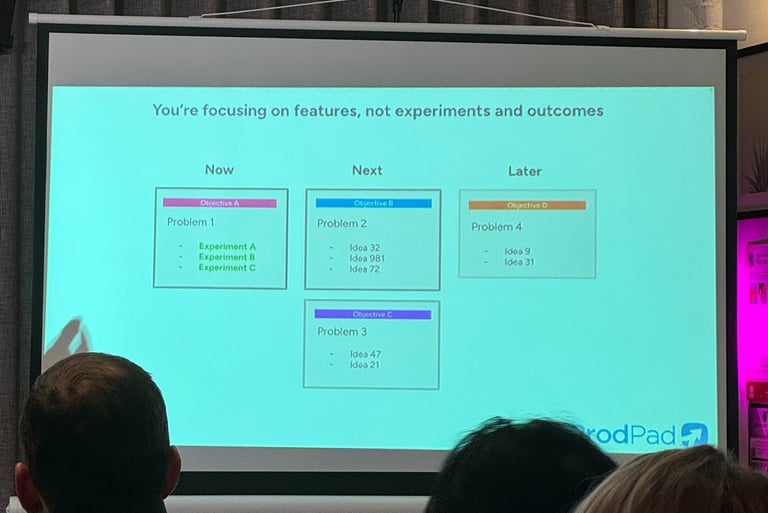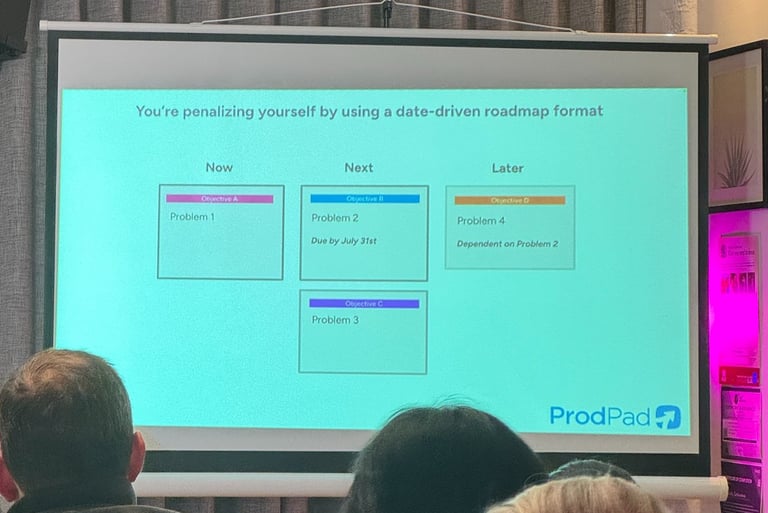Spending another cold evening at this networking event. I always love to meet new people in real life and have some quality conversations and a great time.
Now Next Product(here) is an event series I have been trying to join. The event seats fill up quickly, and I finally understand why after attending my first NNP event. It's so popular that the room was packed!
A few topics covered during the event...
How Customer Experience Impacts Product
In this lightning session, Paul Dunlop (Group Product Manager at Google) discussed his onboarding team and the process of setting up a new Android phone, specifically highlighting the pain point of data transfer. Interestingly, only 50% of people are actually completing the data transfer, despite 90% of respondents saying they will do it. This reveals a clear discrepancy between actual data and the ideal customer journey. He explained how to tackle this problem by having the team provide peace of mind for customers - ensuring it's a safe process and supporting customers both online and offline.
Starting my career in a customer experience team as a product person/strategist, I deeply empathize with the struggles Paul described. Even with physical stores and employees as salespeople, controlling training quality and execution remains challenging. Android isn't just for Pixel phones but spans brands like Samsung, and customers from different countries have varying journeys. Customer satisfaction at any stage of the onboarding process can determine whether they'll choose another Android phone. Frustrations during data transfer - like transfers taking too long, forgetting cloud passwords, or not knowing how to proceed - are critical customer experience issues that need solving.
Interesting Insights:
US/India customers tend to visit stores and have salespeople set up their new phones.
UK customers prefer ordering online and self-setup. Successful data transfers by family and friends significantly influence their decisions.
Paul used Twitter/X to collect customer feedback, but caution is needed as these might represent edge cases.
Tipping Point for Dedicated Researcher
Depends on research depth: understanding local or international markets, and data quality
In my current company with many public sector projects, we typically include a service designer or researcher for 8-week discovery phases
In my previous role, as a strategist, I also acted as a researcher across different business touchpoints to improve sales
Mentorship in Career
Valeria (Product Manager at Treeapp) shared her career journey and how she used empathy in conversations to advance. She recommended mentorship programs that can significantly benefit one's career.
I believe a good mentor can be invaluable. My first mentor, though not sharing my exact career path, had nearly 40 years of industry experience and over 10 years at his company. This mentorship helped me understand workplace dynamics and build relationships. We maintain a good connection to this day. My second mentor at my current company guided me when I felt lost, providing professional advice that helped clarify my career direction.
Recommendations:
Look for mentors beyond online platforms (i.e. ADPList - this is my invite link)
Sign up for workplace mentorship programs
Actively seek online mentorship
Schedule coffee chats
Keep your LinkedIn profile updated
I would definitely recommend watching these videos if you're unsure how to start:
https://youtube.com/shorts/OiOk7RrStRc?si=PnU0mmYdaAmyvV2K
Her success story:
https://youtube.com/shorts/K4hMON7hMW8?si=JCChjJK3S5aAy-ck
https://youtu.be/MSyFfoWtG1E?si=5AEKOlgrJlifA-ar&t=466
Improv - You Don't Have to Be Funny or Clever
In Paul Pechey's talk, this was my first exposure to the term "Improv". When giving presentations, talks, or engaging in conversations, being funny or clever shouldn't be your primary focus - it will come naturally.
Other tips:
Listen actively
I have got your back
Set the scene (what’s problem you are solving, where are you going)
Yes and
Dos and Don'ts for Roadmaps
Janna Bastow (Co-founder of Mind The Product) shared two roadmap types: timeline-driven and now/next/later (which she prefers).
✅Dos :
Prioritise problems
Consider outcomes
Adjust detail levels when presenting to different teams
Use colour coding based on objective levels for quick pattern recognition
Include a separate block for completed work to review what worked, what was tried, and what didn't
❌Don'ts:
Prioritise ideas
Prioritise features
Hide your roadmap (it's a strategy prototype - seek feedback before commitment)
I shared that my current project uses a timeline-based roadmap due to organisational constraints. With potential punishments for incomplete work, adopting a now/next/later model seems challenging. Joanna noted that this depends on whether an organisation is product-led, with timeline-based roadmaps typically reflecting a more delivery-focused approach.




It's worth getting out of your home in this cold weather. You will meet a lot of amazing people (not only speakers) and learn something to bring to your work. Say hi to me if we meet at any of these events. 👋🏻
If you find my articles helpful, would you buy me a bubble tea?
(Click here to buy me a bubble tea)
